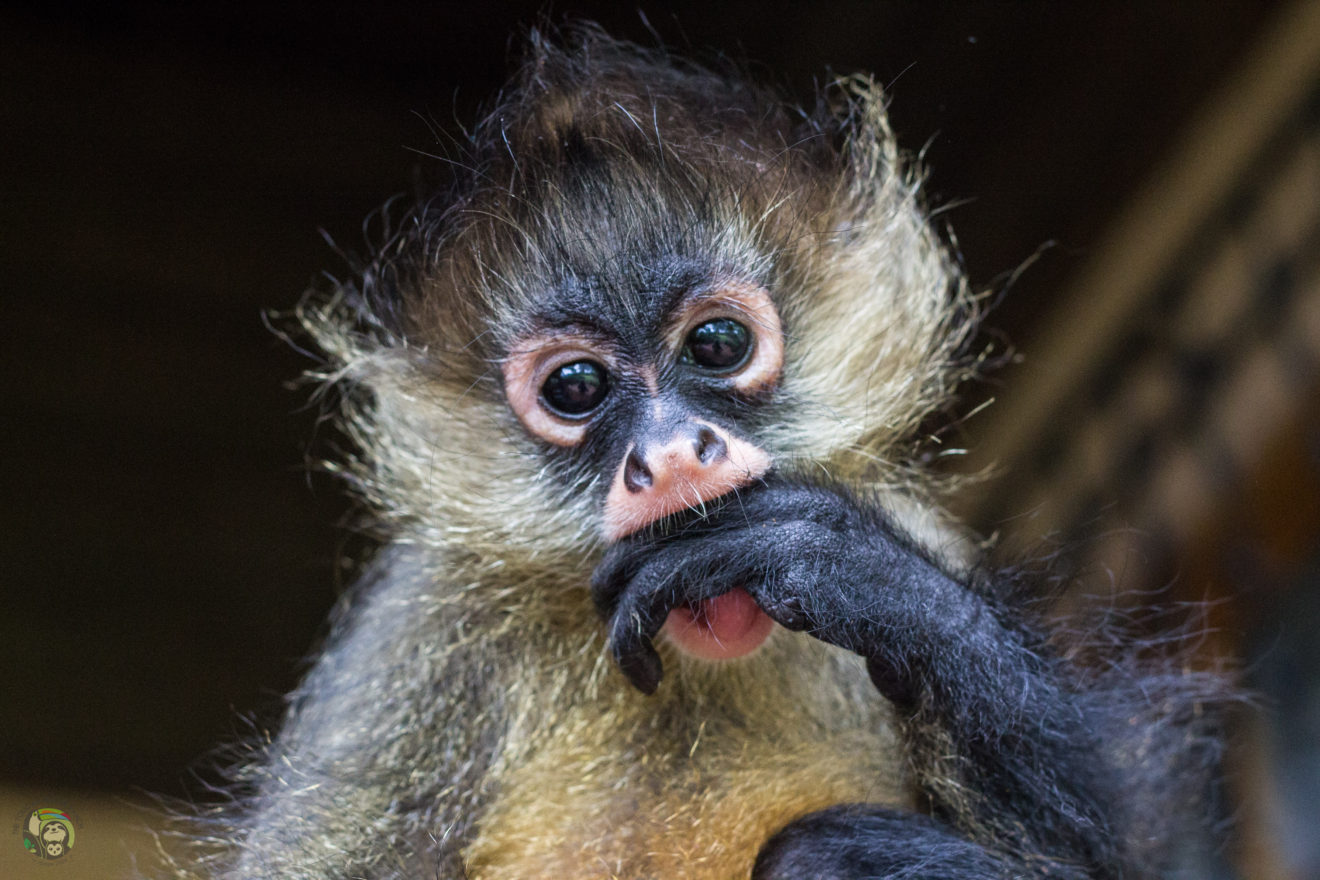Spider monkeys are New World monkeys belonging to the genus Ateles, part of the subfamily Atelinae, family Atelidae. They are found in tropical forests of Central and South America, from southern Mexico to Brazil and Guyana.
They are divided in seven species including the critically endangered Black-headed Spider Monkey and Brown Spider Monkey
Their disproportionately long limbs and long prehensile tails make them one of the largest New World monkeys and give rise to their common name.
They live in the upper layers of the rainforest, and forage in the high canopy, from 25 to 30 m (82 to 98 ft). They primarily eat fruits, but will also occasionally consume leaves, flowers, and insects.
They are social animals and live in bands of up to 35 individuals but will split up to forage during the day. Recent studies indicated spider monkeys are the most intelligent New World monkeys.
They can produce a wide range of sounds and will “bark” when threatened; other vocalisations include a whinny similar to a horse and prolonged screams.
Spider monkeys are susceptible to malaria and are used in laboratory studies of the disease.
Behaviour Of The Spider Monkeys
- Spider monkeys form loose groups, typically with 15 to 25 individuals but sometimes up to 30 or 40.
- Spider monkeys communicate their intentions and observations using postures and stances, such as postures of sexual receptivity and of attack.
- Spider monkeys are diurnal and spend the night sleeping in carefully selected trees.
Diet Of The Spider Monkeys
Their diet consist of about 70 to 85 percent of fruits and nuts.
They eat the fruits of many big forest trees, and because they swallow fruits whole, the seeds are eventually excreted and fertilized by the feces.
Spider monkeys have a unique way of getting food: a lead female is generally responsible for finding food sources. If food is scarce, they may eat insects, leaves, bird eggs, bark and honey.
Reproduction
Spider monkeys are polygynous, one male mating with multiple females. The female monkeys are very particular about who they will mate with and may reject several of them before making their selection. Both males and females use “anogenital sniffing” to check their mates for readiness for copulation. The gestation period ranges from 226 to 232 days. Each female bears only one offspring on average, every three to four years.
Surprising Facts About The Spider Monkey
- Spider monkeys get their name from their spider-like appearance when they hang by their tails from the bow of a tree. Their prehensile tail is so strong and well-developed for arboreal life that it can be used as an extra arm. The tail even lacks hair on the underside so that the monkey can get a better grip on a branch while using both hands to gather fruit.
- Spider monkeys don’t have thumbs on their hands. The spider monkey is simply more specialized and the thumb has evolved away because it isn’t needed. Their hands have only vestigial thumbs, the tiny nub left over from their ancestors, who did have thumbs. The absence of this extra digit gives the spider monkey a more hook-like hand with long slender fingers, providing a better grip to swing from branch to branch in its arboreal abode. Spider monkeys do have opposable thumbs on their feet, like most other primate species.
- Spider monkey troops are matriarchal, meaning the females play a leadership role. Females actively choose their mates when breeding, and tend to make the decisions for the group. Wildlife Waystation notes that even the group size is ultimately determined by the alpha female of the troop.
- Spider monkeys are smart, with a brain weighing 107 grams and twice the size of that of the Howler monkey, which has about the same size of the body.
- Rather than leap from tree to tree, spider monkeys are specialists at swinging from limb to limb, and can clear great distances in a single swing. Spider monkeys can cover as much as 40 feet of distance with a single powerful swoosh of their arms. The hook-like hands discussed above, as well as extra mobile shoulder joints assist spider monkeys with their impressive moves.
- There are seven species of spider monkey, all of which are under threat of extinction. Two species — the black-headed spider monkey and brown spider monkey — are critically endangered.
- During the night, spider monkeys gather in large groups and sleep in the trees, where they are safe from the predators. Main predators of spider monkeys are jaguars, pumas, ocelots and large snakes.
- When different troops of spider monkeys meet, they hug each other to express greetings and avoid confrontation and potential aggression.
- Spider monkey can survive 22 to 25 years in the wild and up to 35 years in captivity.
Watch This: Swing Through the Trees With Amazing Spider Monkeys | National Geographic
About Spider Monkeys
Spider monkeys are known for their lanky frames and incredible ability to leap from tree to tree. They eat Fruits but sometimes consumes leave, insects etc. They are sociable and also considered the most intelligent New World monkeys.
Article References:
- https://en.m.wikipedia.org/wiki/Spider_monkey
- http://animalia.bio/spider-monkey
- https://iheartanimals.com/5-fun-facts-about-spider-monkeys/







